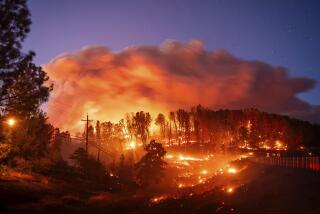Brush at Firebreak Too Green to Cooperate : Torch-Carrying Crews Can’t Keep Flames Alight
Los Angeles and Ventura county fire crews worked into the night Monday to burn a 100-foot-wide, 15-mile-long loop in the rugged mountains north of Simi Valley.
Given favorable weather, the 5,000 acres of grass and brush circumscribed by that circle will be ignited today or tomorrow in the largest controlled burn attempted in either county.
Almost two months after a similar, smaller fire a few miles to the east blazed out of control, causing a power loss at Magic Mountain, firefighters took a cautious approach to Monday’s fire, which was centered on a steep and scenic ridge line overlooking the Simi Valley to the south and the Santa Clara River to the north.
Ring of Fire Planned
Their plan was to light a tiny fire first to test the combustibility of the sage and grass and, if all went well, to spend the rest of the day burning the giant ring that would contain the larger fire.
About 300 firefighters and detention-camp workers met for a briefing at 10 a.m. and then broke into four divisions and scattered along miles of winding roads between Tapo Canyon and Salt Canyon.
The firefighters, in yellow jump suits, carried hand torches and flares to ignite the fire.
The detention crews, in orange jump suits, carried hoes, axes and chain saws to smother any fire that broke out where it didn’t belong.
About noon, one of the detention crews spread out along a grassy hilltop. A fireman with a torch walked in front of the workers, lighting a line of fire.
It moved lazily through the grass. The work crew stood at ease, having nothing to do.
The firefighter tried a stand of chaparral. It crackled and burned with some authority. But the fire spread slowly.
By 1 p.m., the joint command, consisting of Capt. Scott Franklin of Los Angeles County and Capt. George Lund of Ventura County, decided it was safe to go ahead full steam.
But the fuel wasn’t cooperating. The chaparral was unseasonably green, and a growth of new green was coming up under the dry summer grass.
The fire moved grudgingly from ridge to ridge and gully to gully, leaving unburned spots behind.
New Fire-Setting Device
The commanders called in the helicopter. Instead of employing their usual tool--a massive napalm torch suspended by a cable from the copter--they decided to test a new fire-setting device.
Resembling an oversized gum-ball machine, it hangs out of a helicopter’s open door and drops small plastic balls about the size of Ping-Pong balls. Each ball is filled with granules of potassium permanganate and is injected with glycol just before it drops. Thirty seconds later, the ball bursts into flame.
At 2 p.m., the helicopter took off.
A ground crew guided the copter up a ravine. The Ping-Pong balls dropped and ignited. But the fire wouldn’t spread.
By 3 p.m., the same word was coming in from all fronts. The fire would burn a little, but it just wouldn’t get going.
Not giving up, a Ventura County crew patrolled the dirt roads taking shots at the unburned spots with technology from World War II: a small pump that squirted diesel fuel through a nozzle at the end of a hose--a blow gun.
Oblivious to the flame that leaped over his back and the smoke that roiled around him, a firefighter walked up the road, burning everything in his path.
It was a gallant effort. But by dusk, it hadn’t been enough. Much of the perimeter remained unburned. They’ll have to finish the job today.
More to Read
Sign up for Essential California
The most important California stories and recommendations in your inbox every morning.
You may occasionally receive promotional content from the Los Angeles Times.











